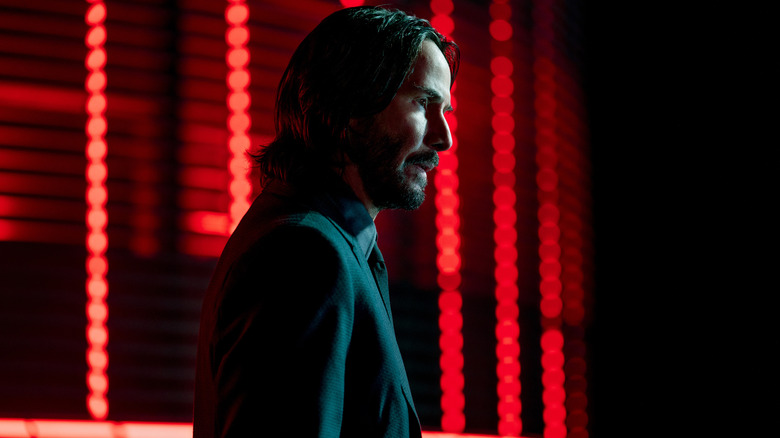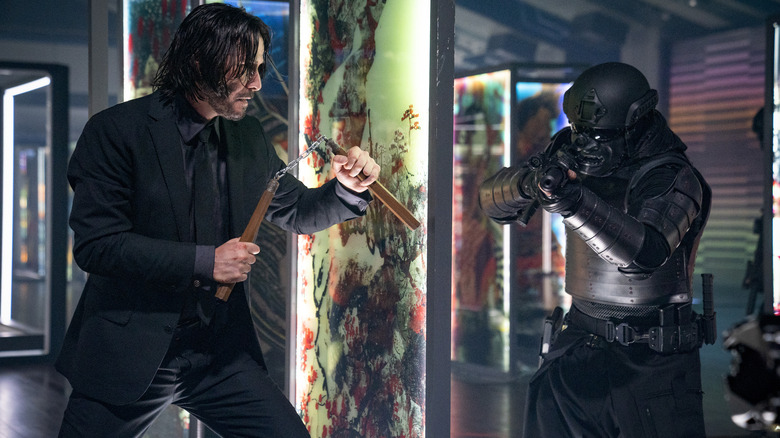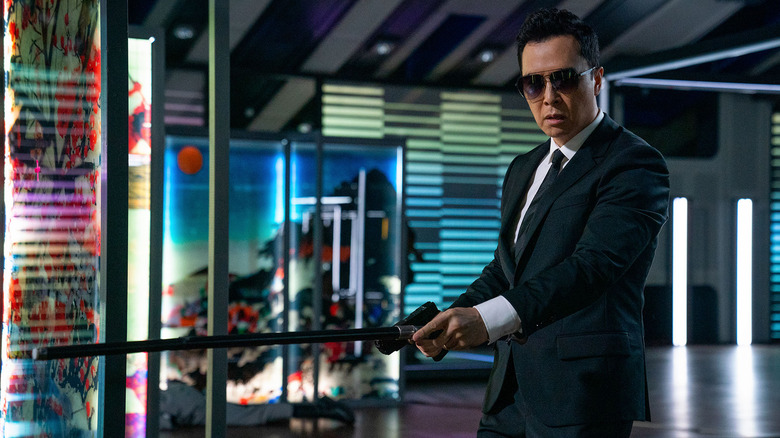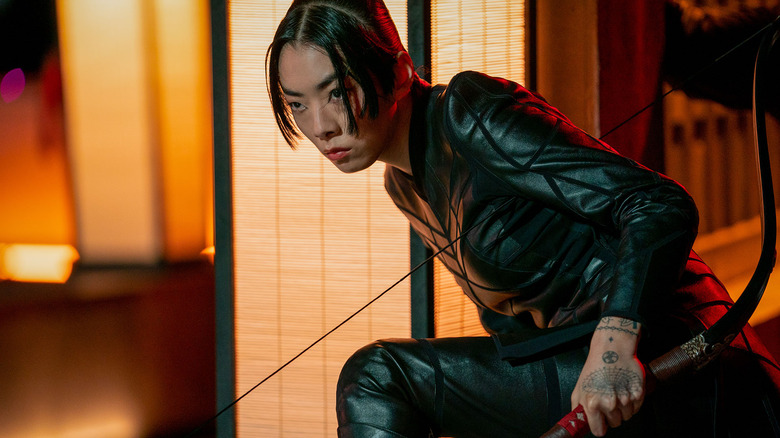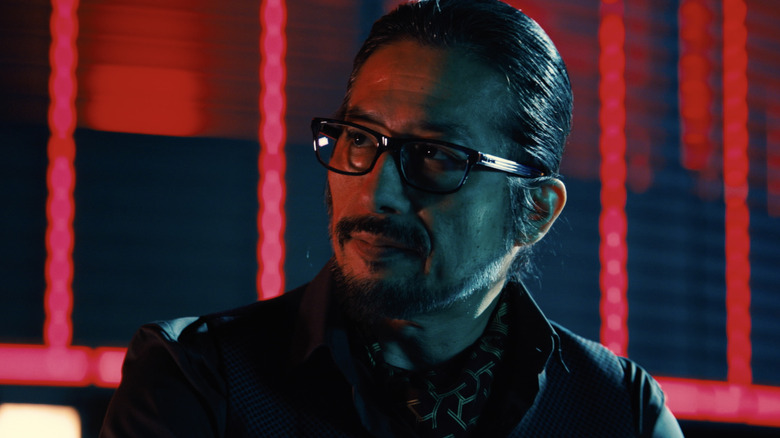John Wick 4's Osaka Action Scene Sets A High Bar – And The Rest Of The Movie Can't Clear It
This post contains spoilers for "John Wick: Chapter 4."
The final hour of "John Wick: Chapter 4" is one of the most relentless action sequences ever put in a movie. For many, this will be a total thrill ride. For me, I found it to be pretty tedious. I felt as if I was being bludgeoned by an endless barrage of gunfire that become monotonous to the point where I was tuning out the movie. I have written about my issues with guns and the "John Wick" series and saw "Chapter 3" as an evolution that made them effective to me. But here, it was just too much and a step backwards.
What made this turn of events even more disappointing was that I found the first half of "Chapter 4" to be completely thrilling — priming it to be the best "John Wick" picture. In particular, the first major action set piece in the Osaka Continental Hotel gripped me arguably more than any other set piece throughout the entire series. Yes, it featured plenty of the signature Wick gun-fu, but it expanded the palette of what we have come to know this franchise can deliver in terms of action. Alongside the choreography and how the fights were designed for the sequence, it also juggled many different characters and motivations with great ease that made the sequence not just viscerally satisfying but emotionally gripping as well. The Osaka sequence is a triumph, and unfortunately, the rest of the movie struggles to match its high-wire act.
A variety of weaponry
Part of my distaste with the guns in the "John Wick" comes from my real-world disdain for an instrument of death, but my problems also come from them becoming boring really fast in an action scene. I can only watch someone stand and point a gun at someone as the deafening sound of bullets firing plays over the speaker for so long before I'm waiting for them to wrap the scene up. The Osaka sequence features plenty of guns, but that is not the only card on the table, as it is in the film's final hour. We are also given everything from a squadron of archers to a pair of head-cracking, sumo-wrestling bodyguards to John Wick wielding nunchucks, and that isn't even the full list of ways people fight in this sequence.
For a great action set piece, evolution is a necessity. Like any other scene in a film, action should also be telling a story, and drama requires peaks, valleys, and movement to be successful. If your scene is someone shoots a bunch of people in a room, that scene can't simply escalate to them shooting a bunch more people in another room. That isn't progress. That's just the same thing but longer. By changing up what kind of weapons are being used, it presents new challenges for the characters to overcome. John Wick runs out of bullets, so he grabs nunchucks to solve the problem of him being unarmed. That kind of detail not just varies what kind of action you are seeing but signals an ingenuity from the character that otherwise wouldn't have been displayed. Plus, nunchucks and bows and arrows are just way more cinematically exciting than guns.
Letting Keanu Reeves and Donnie Yen do their thing
A major selling point of "John Wick: Chapter 4" is pitting Keanu Reeves against Hong Kong action movie legend Donnie Yen. Never before in this series has an actor with his success and renowned physical prowess been a major adversary for John Wick. The finale of the movie has them against one another in a duel, but that's a deliberately still sequence. Calling it an action scene would be a lie. The only time these two really get to throw down is in Osaka, and as you'd expect, the results are spectacular.
Beyond them going at it, I'd argue this is the only sequence where Donnie Yen really gets to shine. He gets this fabulous introduction eating in the hotel kitchen and being called into action. The character he plays, Caine, is blind, and his fighting style doesn't betray that reality. He misses people and occasionally misjudges space. I love the detail of using the motion sensor doorbells to thwart stealth attackers, and him using his cane as how a blind person would use your average cane as well as a bludgeoning instrument and a sword adds even more fun variety to the set piece.
Arguably the best beat of the entire sequence features no action whatsoever, the two have exchanged a barrage of gunfire at close range through a stained glass display. Wick is motionless on the ground and sees Caine plainly in front of him, who is wondering if Wick is dead. It's a beautiful character moment as you see that Wick doesn't want to kill his old friend and also builds a tremendous amount of tension for when Wick inevitably makes a noise. Though the final dual is the true climax, this will be their battle I remember.
Introducing a new favorite
As someone completely unplugged from the popular music scene, I had absolutely no idea who Rina Sawayama was prior to "John Wick: Chapter 4." Come to find out she is a pop star, and this is her first movie. Who knew?! (Everyone else.) From the second she showed up on screen as the concierge of the Osaka Continental, I immediately thought this was someone who commanded the screen. I wasn't sure if she was going to get involved in the action, as the New York concierge played by the late, great Lance Reddick rarely did, but when she whips off her kimono and grabs a bow, I got amped. She's sinking arrows into guys' faces at point blank range and has one of the best beats of the whole sequence, continuously stabbing a large man as he tries to crawl up a staircase.
What is also wonderful about this character is that even within this relatively small frame of time, her emotional stakes are incredibly clear. Her father (Hiroyuki Sanada) runs the Osaka Continental and is old friends with John Wick. She resents Wick for putting her father in immediate danger but understands why she must fight alongside him. When she witnesses the death of her father and Caine acknowledges that she will come for revenge in the future, you want her to find her justice even though you've barely spent time with this woman. Whether or not this sets up a proposed spinoff, we don't exactly know (though the post-credits scene certainly indicates that), but it speaks to Sawayama and the filmmakers that within this big action set piece they can still tell a full character story. I certainly hope to see more Rina Sawayama as Akira in the future.
A fitting conclusion to the sequence
The finale of the Osaka sequence, like the ending of the climactic set piece, ends in a duel, and even though the finale involves the death of the character we've been following for four movies, I found myself more emotionally moved by the death of Hiroyuki Sanada's Shimazu Koji, the manager of the Osaka Continental. As is the case with every major character in this sequence, you completely understand his motivation. He is a man whose loyalties lie in his history and not by the machinations of the High Table. This is also a battle between two fathers looking out for the futures of their daughters. Where Wick's death feels like an inevitability and almost a sigh of relief, Koji's is tragic, noble, and meaningful.
From the initial confrontation in the Osaka Continental lobby to John Wick and Akira saying their parting words on a subway train, the Osaka section of "John Wick: Chapter 4" could not have been executed better. The characters, the emotions, the storytelling, the choreography, the construction, and the gorgeous cinematography by Dan Lausten captures an entirely satisfying meal of action filmmaking. Unfortunately, there's still over 90 minutes of movie left, and no other major set piece in the film comes close to executing something that spins so many plates at once. They fall back into the fairly repetitive gun-fu where their only move is to think, "more." Not only do I find it disappointing because this is presumably the end of the story of John Wick, but I find it more so because I know they can craft a masterful set piece. They did it earlier in the film, and I look forward to watching it again and again.
